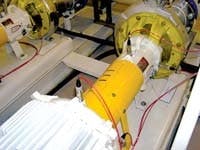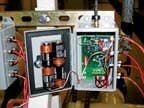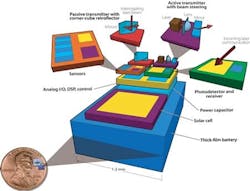Wireless vibration sensors save tens of thousand in equipment operation and maintenance costs
When the new machine arrives at your plant, you’ll push a button that will put internal programs in motion to introduce the new machine to your asset-management and CMMS software. From then on, you will be able to monitor the health of the new machine, spot problems before they get serious, and save thousands of dollars in operating and repair expenses.
You won’t have to run a single wire. That’s because the sensors on those machines will automatically become part of a wireless condition-monitoring network.
Farfetched? Hardly. In fact, you can do it yourself today. The wireless vibration sensors cost a lot more than $5 now, but the economics are the same: Wireless sensor networks let you spend hundreds of dollars to save tens of thousands of dollars in equipment and machinery operation and maintenance costs.
Engineers like you are busy installing wireless sensor networks on machinery and equipment already. For example, at Intel’s Ronler Acres semiconductor fabrication plant in Hillsboro, Ore., vibration engineer Mick Flanigan is working with wireless vibration sensors. It’s all still in development, Flanigan says, but the results are promising. “We are monitoring pumps, compressors, and other plant facilities equipment with vibration sensors,” he reports. “Each machine [Figure 1] has from one to 12 vibration sensors, and each sensor reports via wireless to a central Stargate wireless processor, which converts the data from up to 12 sensors and transmits it to a PC that runs Rockwell Automation’s ENSHARE asset management software.”
Figure 1. At Intel’s semiconductor fab plant in Hillsborough, Ore., each of these high-speed Durco process water pumps has six vibration sensors. The sensors connect via the red wires to a mote, which transmits data via a wireless sensor network. The mote is battery powered, and supplies power to the sensors. Installed cost is about $1,000, compared to about $8,000 for a conventional system.
Engineers like Flanigan will lead the way into the wireless sensor world. Instrumentation and control applications, which stand to gain similar benefits from wireless networks, are less able to adopt such radical technology. Condition-monitoring applications can better accept the risk of an interrupted signal and stand to gain the most from the lower costs, so these sensors are getting their first industrial tryouts in maintenance and system-monitoring applications.
Into the mote
At the heart of wireless sensor networks lie some tiny processors, called dust, motes or sensor nodes. A mote is a tiny $50 processor made by Intel. It’s about the size of your fingernail (Figure 2), is battery operated, communicates via wireless Ethernet, and has a small operating system (TinyOS) and enough memory and hardware capability to perform control and monitoring tasks. Mote technology can put a Web-enabled processor at every sensor and actuator. Motes think smallAs long as another mote is within 100 ft. or so, it requires no hardwired network. Hundreds of motes in a plant form a spider web-like mesh or sensor network that provides a virtually unlimited number of pathways to pass information back and forth. Such a network has multiple levels of redundancy because if any mote fails, dozens of others stand ready to move network traffic.
Similar devices are available. Mote is the term used for sensor nodes created by the University of California-Berkeley and its partners, including Crossbow and Intel. TinyNode is another example; it is a sensor/actuator node produced by Embedded Research Solutions, Annapolis, Md. According to Dr. David B. Stewart, EVP/CTO at ERS, instead of TinyOS, TinyNodes use a real-time sensor networking infrastructure called Miniature Software Technology.
Dust is an even smaller mote (Figure 3). Solar-powered versions are being used today to monitor temperature, humidity and other parameters in farm fields, bird nesting grounds, wineries and similar outdoor applications.
The National Institute of Standards and Technology (NIST) calls all this technology “pervasive computing.”
Figure 3. This solar-powered mote, developed at the University of California-Berkeley in 2001, fits in a cubic millimeter. Called “smart dust,” it has wireless communications and a programmable microprocessor. In one application, researchers fit temperature, humidity, barometric pressure, light intensity, tilt, vibration and magnetic field sensors — plus the mote and a battery — in a 1-cu.-in.-package.
Because motes and dust can self-configure their dynamic wireless networks, the Defense Advanced Research Projects Agency (DARPA), the central research and development organization for the Department of Defense, is very interested, and is funding much university research. DARPA wants to be able to drop a few thousand sensors over a battlefield and have them form a huge wireless network, then send back information on troop movements, vehicle movements, video from the ground and so on.
At the Twentynine Palms Marine base in Southern California, DARPA tried out a prototype system. An aircraft dropped 30 wireless magnetic sensors along a road. Once safely on the ground, the sensors formed a wireless network and began looking for magnetic anomalies caused by passing vehicles. When a sensor detected a vehicle, it relayed the information to the aircraft circling overhead, which transmitted it back to a control center. As each sensor reported data on the passing vehicles, in turn, engineers could determine each vehicle’s speed and direction.
You may already be using a form of motes. RFID technology, for example, is very similar to a mote. An RFID tag does not have a battery. Instead, it uses a pulse of radio energy from a RFID detector to power up its chip and transmit a coded response, typically a product ID. Wal-Mart is trying to perfect RFID technology so it can track products and perform inventory control.
Coming to save the day
Never mind waging war and improving Wal-Mart’s inventory — how can you use mighty motes and dust in your plant? Condition monitoring of machinery is probably the best application so far, but HVAC monitoring is close behind.
Intel’s Flanigan reports that they have 210 vibration sensors installed on 40 machines so far, and will eventually equip about 3,000 machines in the giant Hillsboro plant. Each sensor connects to a mote, which provides the wireless connectivity and the I/O interface to the vibration sensor. One advantage of the wireless system is the reduced cost of installation. Flanigan says the cost to equip a machine with six sensors is about $750 for the vibration sensors and about $250 for the motes, a Stargate modem and enclosures, or about $1,000 per machine. To do it with conventional equipment would cost about $8,000 per machine, Flanigan estimates.
“Wireless costs, being lower than a traditional monitoring system, actually allow us to move to automated collection of data off the ‘Sneaker Net’,” he says. “This gives us greater capacity to collect data more frequently to increase our reliability. Right now, on Sneaker Net, we catch about 80% of our failures because we take only monthly readings — all we can commit to with headcount constraints. With wireless we can collect data as often as we want and will be able to catch and react to those failures with rapid deterioration characteristics.”
Stewart agrees. “The main advantage of using a pervasive computing approach to machine health monitoring and diagnostics is that the number of points being monitored can be increased significantly,” he adds. “It may become possible to sense points that otherwise cannot be sensed using traditional means.”
Whether mote-powered or conventional, the result of deploying condition-monitoring sensors will be the same. “The sensor network will help bring all the data back to a central computer, much like traditional systems,” Stewart says. “It can do so wirelessly, instead of having to bring dozens or hundreds of individual wires from each sensor. But decisions as to whether maintenance is needed, who performs it, etc., will remain the same. With more information from more sensing points, better decisions about maintenance can be made.”
London-based BP outfitted the Loch Rannoch, one of its oil tankers, with 160 motes to measure vibration in the ship’s pumps, compressors and engines, according to The Economist (June 10, 2004). “If you want to find an environment that is hostile to a self-configuring, self-powered mote network, you would definitely choose a ship,” says Kenneth Douglas, a technologist at BP. The company is also considering using them in more than 40 other projects, The Economist says. In the next three years, BP expects such networks to start to bind together its information systems with its physical assets. “Sensor networks bridge the gap between software and the real world,” he says.
Other applications exist in HVAC systems, where inexpensive sensors can be used to monitor temperature, humidity, air flow and other parameters at hundreds of locations in a plant, rather than at just a few points as is done today. With hundreds of measurements, the HVAC system can be better tuned for maximum efficiency.
"Self-Organizing Networks have a number of advantages that fit well with typical process plant applications,” says Gabe Sierra, industry marketing manager at the Rosemount Division of Emerson Process Management. “As mote devices are added to a network, the system inherently becomes more robust, with alternative communication paths, self-healing capabilities, and greater distances. Networks can be deployed to mitigate wireless line-of-sight issues that may hinder other wireless topologies. Motes will likely see a relatively fast adoption rate within process plants for monitoring applications.”
James M. DiNanno, marketing manager for Schneider Electric, says wireless monitoring is already here. “We’re already seeing products that incorporate Bluetooth or other wireless technologies in other industries, such as medical devices,” he says. “It hasn’t really arrived yet in industrial applications, but it will. You’ll start seeing it in process applications where you need to measure something, but have no ability to run wires because the object is moving or it’s in an environment that won’t tolerate wires, such as a heat tunnel or chemical bath. Another example is tools on the end of a robot that need to change dynamically. You’ll need to monitor the tools even when they’re not connected to the robot to determine what tools are ready to use, or the operating or maintenance state of the tool.”
Hesh Kagan, consulting engineer for Invensys Process Systems, says, “One of the most immediate benefits of being able to deploy many inexpensive wireless sensors across a process is a heightened ability to make inferential measurements. Most process plants today take measurements at only about 10% of the possible points. Although they might get better results by taking measurements at more points, running the wiring and connecting the sensors is cost-prohibitive. But if the attachment and sensor costs were low enough, as mote technology promises, you could measure at many more points, giving you a much richer process model to work with.”
Dare we infer that inferential measurements could pay off big time? “The richer the process model the greater the opportunity for new, previously impossible measures,” he says. “Real-time strategic measurements of asset availability, asset utilization, condition monitoring, smell, taste, turbidity, quality, value, color, etc. would be all but impossible through a physical sensor. But with enough data points in your model, you can infer real-time measurements. The cost-saving potential for such inferential measurement is tremendous.”
Enough blue sky visionary ideas — let’s get down to the hardware.
Into your plant?
Can you build a sensor network in your own plant? You can buy the necessary hardware easily enough, but better hardware-to-software integration is needed. “We are probably a year away from having commercially available network components and the software to tie them to asset monitoring software,” says Intel’s Flanigan. “However, any reasonably competent engineer can put such a system together today. In my case, the tough part was dealing with the complex vibration data, not the motes.”
Others have overcome the obstacles. Crossbow president Mike Horton told us, “In the case of deploying Crossbow's motes on commercial ships, the motes are used to measure engine vibration. Engine vibration and temperature can be correlated to bearing failure and wear, machine imbalance and shaft misalignment. These are all common causes for machine failure.”
Crossbow is one of the biggest sources of Intel-based motes, so Horton knows of many applications. “We are deploying [motes] in golf courses, nurseries, commercial sea cargos, environmentally sensitive preservations, buildings for security and monitoring, vineyards, factories and military applications,” Horton says. “Crossbow has been selling motes to end users for a few years now. Our customers range from individuals to Fortune 100 companies.”
Other vendors providing sensor nodes and development kits include Embedded Research Solutions, Dust Inc., Ember and 8D Technologies.
If you buy a $150 mote development system, it comes with 128 KB of program Flash memory, 256 KB of data Flash memory, a 900 MHz radio and the TinyOS operating system, which is a slimmed down (8 KB) version of Linux. What can you do with a mere 384 KB of memory? For one thing, you can run TinyDB, a slimmed-down SQL database that lets you store a reasonably large amount of data.
Having worked on the NASA space program 30 years ago, I can tell you that we sent the Apollo spacecraft to the moon with a flight computer that had only 64 K words of memory (128 KB). If we could do that, you can do anything.
Depending on the vendor supplying the mote, dust or sensor node development system, you will most likely develop all the programming on a PC using a high-level configuration program, debug it using a simulator, then download your monitoring or control program to the mote’s Flash memory. Once it’s programmed, you can download updates from a central server.
If you want to try all this out by installing your own motes and wireless sensor network, you will have to solve a few operational bugs.
First, there is the problem of battery life. It seems that motes tend to go through batteries fairly fast. Some say that batteries should last three to five years, but this is dependent upon how often the mote is awake and how much it sleeps. To last five years, it probably will have to sleep 98% of the time.
Second is the problem of dealing with TinyOS. It’s no full-blown Windows operating system, so you’ll have to learn to live with a minimum of support programs.
Third is the wireless network. It’s not standardized yet. Kagan says, “Standards organizations such as ZigBee, the 802.15.4 committee, and the Wireless Industrial Networking Alliance (WINA) are all working to make wireless standards and products more appropriate for industrial applications.”
Stewart of ERS says there is a difference between the types of applications they are targeting as compared to motes, which come out of DoD research. “The DoD is interested in dropping thousands from an airplane and having them self-organize, and to work around those that don't work,” Stewart says, “Hence the focus on the networking part. In commercial and industrial applications, the goals are different. Functionality, reliability, diagnostics, and low-power performance are more important than complex networking strategies.”
Stewart claims that ERS’ Miniature Software Technology is designed especially for commercial and industrial applications. Anyone who wants to tinker with sensor networks probably should look at both approaches.
Fourth is the problem of data compatibility. Intel’s Flanigan reports that they are still working out the details of converting all the raw vibration data into a format that the Rockwell asset management software will accept. It’s just a matter of time until they figure it out, he says.
Nevertheless, there is no reason why you can’t give motes, dust or sensor nodes a try. You can install vibration sensors on a rotating machine, connect them to a wireless node, store the data in TinyDB, and periodically send it off via wireless to your asset management software. If you are successful, and save $7,000 per machine, you’ll be a hero.
Although motes, dust, sensor nodes and sensor networks are not quite ready for the public to handle, many people predict that they will be within five years. If you manage to get a jump on your colleagues by becoming familiar with the technology and gain experience by doing your own installations, you could become a valuable commodity inside your company or in the job market. When the great sensor network revolution finally comes to town, you’ll be ready for it.
Figures 1 and 2 courtesy of Intel.
Figure 3: B.A. Warneke, M.D. Scott, B.S. Leibowitz, L. Zhou, C.L. Bellew, J.A. Chediak, J.M. Kahn, B.E. Boser, K.S.J. Pister, "An Autonomous 16mm^3 Solar-Powered Node for Distributed Wireless Sensor Networks, IEEE International Conference on Sensors 2002, Orlando, FL, June 12-14, 2002. Copyright IEEE.
Rich Merritt is Senior Technical Editor for Plant Services, Control, and Control Design magazines.




